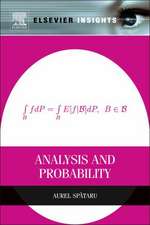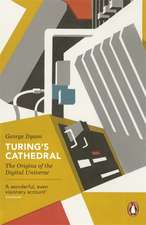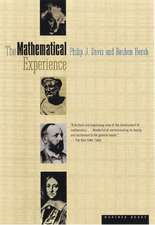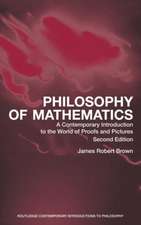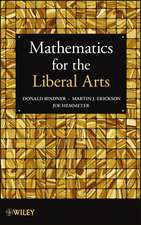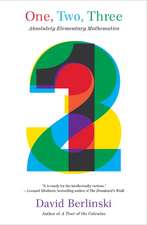Infinite Ascent: A Short History of Mathematics: Modern Library Classics (Paperback)
Autor David Berlinskien Limba Engleză Paperback – 31 dec 2007
Berlinski focuses on the ten most important breakthroughs in mathematical history–and the men behind them. Here are Pythagoras, intoxicated by the mystical significance of numbers; Euclid, who gave the world the very idea of a proof; Leibniz and Newton, co-discoverers of the calculus; Cantor, master of the infinite; and Gödel, who in one magnificent proof placed everything in doubt.
The elaboration of mathematical knowledge has meant nothing less than the unfolding of human consciousness itself. With his unmatched ability to make abstract ideas concrete and approachable, Berlinski both tells an engrossing tale and introduces us to the full power of what surely ranks as one of the greatest of all human endeavors.
From the Hardcover edition.
Din seria Modern Library Classics (Paperback)
-
 Preț: 62.93 lei
Preț: 62.93 lei -
 Preț: 96.71 lei
Preț: 96.71 lei -
 Preț: 117.32 lei
Preț: 117.32 lei -
 Preț: 74.62 lei
Preț: 74.62 lei -
 Preț: 98.78 lei
Preț: 98.78 lei -
 Preț: 86.54 lei
Preț: 86.54 lei -
 Preț: 75.50 lei
Preț: 75.50 lei -
 Preț: 114.93 lei
Preț: 114.93 lei -
 Preț: 138.81 lei
Preț: 138.81 lei -
 Preț: 56.52 lei
Preț: 56.52 lei -
 Preț: 75.50 lei
Preț: 75.50 lei -
 Preț: 56.71 lei
Preț: 56.71 lei -
 Preț: 65.15 lei
Preț: 65.15 lei -
 Preț: 81.47 lei
Preț: 81.47 lei -
 Preț: 89.31 lei
Preț: 89.31 lei -
 Preț: 111.11 lei
Preț: 111.11 lei -
 Preț: 117.16 lei
Preț: 117.16 lei -
 Preț: 55.66 lei
Preț: 55.66 lei - 5%
 Preț: 100.14 lei
Preț: 100.14 lei -
 Preț: 112.38 lei
Preț: 112.38 lei -
 Preț: 84.98 lei
Preț: 84.98 lei -
 Preț: 116.94 lei
Preț: 116.94 lei -
 Preț: 75.68 lei
Preț: 75.68 lei -
 Preț: 86.42 lei
Preț: 86.42 lei -
 Preț: 137.99 lei
Preț: 137.99 lei -
 Preț: 73.64 lei
Preț: 73.64 lei -
 Preț: 127.85 lei
Preț: 127.85 lei -
 Preț: 75.46 lei
Preț: 75.46 lei -
 Preț: 106.63 lei
Preț: 106.63 lei -
 Preț: 109.29 lei
Preț: 109.29 lei -
 Preț: 70.53 lei
Preț: 70.53 lei -
 Preț: 83.94 lei
Preț: 83.94 lei -
 Preț: 70.53 lei
Preț: 70.53 lei -
 Preț: 95.10 lei
Preț: 95.10 lei -
 Preț: 135.68 lei
Preț: 135.68 lei -
 Preț: 105.16 lei
Preț: 105.16 lei -
 Preț: 75.90 lei
Preț: 75.90 lei -
 Preț: 113.03 lei
Preț: 113.03 lei -
 Preț: 88.47 lei
Preț: 88.47 lei -
 Preț: 66.01 lei
Preț: 66.01 lei -
 Preț: 51.16 lei
Preț: 51.16 lei -
 Preț: 45.18 lei
Preț: 45.18 lei -
 Preț: 46.00 lei
Preț: 46.00 lei -
 Preț: 56.71 lei
Preț: 56.71 lei -
 Preț: 50.10 lei
Preț: 50.10 lei -
 Preț: 50.91 lei
Preț: 50.91 lei -
 Preț: 47.23 lei
Preț: 47.23 lei -
 Preț: 51.57 lei
Preț: 51.57 lei -
 Preț: 46.17 lei
Preț: 46.17 lei
Preț: 108.59 lei
Nou
Puncte Express: 163
Preț estimativ în valută:
20.78€ • 21.69$ • 17.20£
20.78€ • 21.69$ • 17.20£
Carte disponibilă
Livrare economică 14-28 martie
Preluare comenzi: 021 569.72.76
Specificații
ISBN-13: 9780812978711
ISBN-10: 0812978714
Pagini: 197
Ilustrații: DIAGRAMS THROUGHOUT
Dimensiuni: 133 x 203 x 11 mm
Greutate: 0.16 kg
Editura: Modern Library
Seria Modern Library Classics (Paperback)
ISBN-10: 0812978714
Pagini: 197
Ilustrații: DIAGRAMS THROUGHOUT
Dimensiuni: 133 x 203 x 11 mm
Greutate: 0.16 kg
Editura: Modern Library
Seria Modern Library Classics (Paperback)
Notă biografică
David Berlinski received his Ph.D. from Princeton University and has taught mathematics, philosophy, and English at Stanford, Rutgers, the University of Puget Sound, and the Université de Paris at Jussieu. He has been a research fellow at both the International Institute for Applied Systems Analysis in Austria and the Institut des Hautes Études Scientifiques in France. His many books have been translated into more than a dozen European and Asian languages. His essays in Commentary have become famous. A senior fellow at the Discovery Institute in Seattle, he lives and works in Paris.
From the Hardcover edition.
From the Hardcover edition.
Extras
Chapter 1
Number
The history of mathematics begins in 532 BC, the date marking the birth of the Greek mathematician Pythagoras. Having fled the island of Samos in order to escape the tyranny of Polycrates, Pythagoras traveled to Egypt, where, like so many impressionable young Greek men, he “learned number and measure from Egyptians [and] was astonished at the wisdom of the priests.” Thereafter, he settled in southern Italy; he began teaching and quickly attracted disciples. Very little is known directly of his life, except that his contemporaries considered him admirable. Nothing from his own hand remains: He has been preserved against the worm of time by the amber of various literary artifacts. Admission to the Pythagorean sect was evidently based on mathematical ability. Secrecy was enforced and dietary restrictions against beans maintained. New members were required to keep silent for a number of years, a policy that even today many teachers will find admirable, and they were expected during this time to meditate and reflect. Some members of the Pythagorean sect regarded the external world as a prison, a cave filled with flickering shadows and dull brutish shapes. Let me add to this confused but static scene the heat lightning of superb mathematical intuition.
Until the mid-twentieth century, the thesis that in mathematics as in almost everything else, the Greeks were there at first light, did not require an elaborate defense. With their forearms draped in friendship over any number of toga-clad shoulders, classicists who had spent years mastering infernal Greek declensions naturally assumed that the “Greeks were fellows of another college.” The history of the Ancient Near East has come into sharper focus over the past century, great scholars poring over cuneiform tablets and re-creating the life of ancient empires that had until their work been swallowed up as the impenetrable before. They have found remarkable things, a history before classical history, evidence that men and women have used and loved mathematics in the time before time began. Neolithic ax-marks have even suggested that the origins of mathematics lie impossibly far in the past, and that men living in caves, their hairy torsos covered by vile-smelling furs, chipped the names of the numbers onto their ax handles as bison grease spattered over an open fire. And why not? Like language itself, mathematics is an inheritance of the race.
The burden of those impossibly distant centuries now disappears. It is roughly six centuries before the birth of Christ. The Greeks are just about to elbow their way into all the corridors of culture. They give every indication of knowing everything and having known it all along. Yet the Babylonians already possessed a remarkably sophisticated body of mathematical knowledge. They were matchless observational astronomers, and they had brought a number of celestial phenomena under the control of precise mathematical techniques. They were immensely clever. “I found a stone, but did not weigh it,” one scribe wrote. “I then weighed out six times its weight, added two gin, and then added one third of one seventh, multiplied by twenty-four. I weighed it. [The result came to] one ma-na.” “What,” the scribe now asks his oil-haired students, “was the original weight of the stone?” Mathematicians are apt to see an all-too-familiar face peeping through the problems of a Babylonian scribe—their face, of course, ubiquitous and always the same.
But those classicists sipping sherry in the common room of time had been right all along. The Greeks were there at first light.
The natural numbers 1, 2, 3, . . . begin at one and they go on forever, the mathematician’s dainty dots signifying an endless progression. As soon as anyone attempts to cap the natural numbers, anyone can find a way to cap the cap, say by adding one to the last natural number capped. If the numbers are infinite, they are also wonderfully various. When the great Indian prodigy Srinivasa Ramanujan lay dying in a London hospital, the cold English winters eating his lungs away now ending his life, his friend, the mathematician G. H. Hardy, paid him a visit. Paralyzed by his own reticence, Hardy could think only to blurt out the number of the taxi that had brought him to the hospital—1729, as it happens.
“I don’t suppose it is a very interesting number,” he added.
“Oh, no, Hardy,” Ramanujan replied at once, “it is the smallest number expressible as the sum of two cubes in two different ways.”
And so it is: 1729 = 13 + 123 = 93 + 103. No smaller number has this property. The story has become famous. No one quite knows what it means, but every mathematician understands why it is told.
Like Ramanujan, the Pythagoreans were taken with the inexhaustible variety of the natural numbers, their personalities. They were fascinated by 1, 3, 6, and 10, because these numbers could be expressed geometrically as triangles composed of dots. They quite understood the importance of numbers that are divisible only by themselves and 1—the prime numbers such as 2, 3, 5, 7, and 11; and they may well have understood that the prime numbers are fundamental, lying like dark rubies amid the pale panoply of the ordinary numbers. They discovered that certain numbers such as 6, 28, and 496 could be expressed as the sum of their divisors. They lived in caves—I mean such is the legend—and squatting there, a pile of smooth pebbles in their laps, they saw that there are square numbers as well as triangular numbers, and amicable relationships between numbers, as when each of two numbers is the sum of the other’s divisors, or when the sum of two consecutive triangular numbers such as 3 and 6 is a square number, and progressions from one series of numbers to another; and in all this, as the tallow dripped from their candles, they treated the natural numbers as if they were themselves men at play, serious but never solemn, their endless curiosity amounting at times to a form of intellectual rapture and so entirely alien to the beetle-browed scribes and accountants of the Ancient Near East, men forever plodding along the severe utilitarian axis of a commercial culture.
What did the Pythagoreans care for some pharaoh’s monstrous pyramid or staring one-eyed sphinx? They were mathematicians.
Superstitious? Of course they were, but Pythagoras and the Pythagoreans were devoted to a higher spookiness. It is their distinction. With his vein-ruined hands describing circles in the smoky air, Pythagoras has come to believe in numbers, their unearthly harmonies and strange symmetries. “Number is the first principle,” he affirmed, “a thing which is undefined, incomprehensible, [and] having in itself all numbers.” The number one, the Pythagoreans termed the monad, and at times they seemed to suggest that the natural numbers might be subordinated to a dull grunting process by which all of the numbers could be generated from the monad, number creation monstrous and pullulating. “And the first principle of numbers is in substance the first monad, which is a male monad, begetting as a father all other numbers.” The numbers two, three, and four enter into Pythagorean thought scent-marked from the first, the number two, because it is squat and feminine, and three, because it marks a return to the masculine, its three-tipped triangle when inverted (base up, apex down) looking very much as if a pair of wide-spread shoulders were descending toward a manly groin. The number four merits celebration—but I really have no idea why it does, except for the fact that one, two, three, and four sum to ten, at which point the number series topples back to one, with eleven expressed as the sum of one and ten. It is the number ten that served the Pythagoreans as the object of a sacred oath, one offered at night in the owl-hooted landscape and dedicated to “him that transmitted to our soul the tetraktys, which has the spring and root of ever-flowing nature.”
Half-mad, I suppose, and ecstatic, Pythagorean thought offers us the chance to peer downward into the deep unconscious place where mathematics has its origins, the natural numbers seen as they must have been seen for the very first time, and that is as some powerful erotic aspect of creation itself. “Number,” the Pythagoreans wrote, “is the essence of all things.” Time has long scattered the Pythagoreans and canceled their sense of play, and yet the declaration that number is the essence of all things has lost none of its thrilling intellectual power. Number? And the essence of all things? Of all things? The Greeks heard those unearthly and mysterious words and tried to give them sense, but sand needed to sift over the monuments of antiquity before they would again enter into the mathematician’s self-confident self-consciousness. When Galileo initiated the great scientific revolution of the West, writing that the Book of Nature is written in the language of mathematics, he was reconveying that Pythagorean note, those Pythagorean words.
The Pythagoreans never succeeded in explaining what they meant by claiming that number is the essence of all things. Early in the life of the sect, they conjectured that numbers might be the essence of all things because quite literally “the elements of numbers were the elements of all things.” In this way, Aristotle remarks, “they constructed the whole heaven out of numbers.” This view they could not sustain. Aristotle notes dryly that “it is impossible that [physical] bodies should consist of numbers,” if only because physical bodies are in motion and numbers are not. At some time, the intellectual allegiances of the sect changed and the Pythagoreans began to draw a most Platonic distinction between the world revealed by the senses and the world revealed by the intellect. The literal aspect of the Pythagorean doctrine gives way. Numbers are one thing, the world of sensory objects another. But numbers still remain the essence of all things, the Pythagoreans groping their way toward the remarkable doctrine that the harmony between numbers offers a guide to the harmony between things.
“To give an example of my meaning,” Aristotle remarked in describing the Pythagoreans, “inasmuch as ten seemed to be the perfect number and to embrace the whole nature of numbers, they asserted that the number of bodies moving through the heavens were ten, and when only nine were visible, for the reason just given they postulated the counter-earth as the tenth.” This is neither muddied nor mystical: The inference on which the Pythagoreans relied has been championed by physicists from the seventeenth to the twenty-first centuries. It is the rock of their faith.
In the 1920s, for example, the French mathematician Paul Dirac set himself the problem of extending the Klein-Gordon field equations so that they encompassed relativistic solutions for the electron. The details of Dirac’s project may safely be subordinated; what is at issue is a risky navigational maneuver in which a man sets off on a road he cannot see trusting for guidance in a road he has already seen. Dirac quickly encountered difficulties. Equations needed to be factored, as when x2 + 11x + 10 is resolved into x + 10 and x + 1, and new mathematical objects were needed to accomplish this. Groping now and guessing like mad, Dirac succeeded in solving the Klein-Gordon equations, the relativistic electron appearing as a physical correlate to a mathematical object. And then Dirac noticed something odd. The solutions to the Klein-Gordon equations were split like the devil’s tail. One solution corresponded to the expected electron, the solution’s negative sign matching the electron’s negative charge; but another and opposite solution seemed to correspond to the electron in all of its properties except charge. Lesser mathematicians might have discretely discarded this anomalous solution and carried on. Dirac ignored their advice and affirmed the existence of the positron.
He had seen the fork on the devil’s tail. Some years later—not many, mind you—experimental physicists confirmed the existence of the positron.
Let us by all means cast out what is unwholesome in Pythagorean lore—the beans, the number mysticism, and the mumbo jumbo. There remains this. The doctrine that number is the essence of all things, passing through the prism of a thousand philosophical tracts, remains the central insight of Western science, the indispensable key of coordination. And this, too: The fact that this key opens so many locks has often been celebrated, but it has never been explained.
Greek historians tell an odd little story. A ship is sailing across the Aegean Sea, the sound of the waves slapping against its wooden hull, the rowers chanting. On board are a number of mathematicians, Pythagoreans all, although why a group of mathematicians should have decided on an ocean voyage, I do not know.
Now Pythagoras is best known in the official history of mathematics for the theorem that bears his name. I am going to need that theorem close at hand, where it can do some good. Consider a right triangle whose tips are labeled A, B, and C. Distances between distant points are what they seem—distances, and so numbers. If distances cannot be correlated with numbers, very little remains of the grand Pythagorean proposition that number is the essence of all things. Although very simple, a right triangle—any old right triangle—is an object quivering with unsuspected numerical relationships; and in particular, Pythagoras discovered that when it comes to any old right triangle, the distances between A and B, and again between B and C, are coordinated with the distance between A and C. They are, in fact, coordinated by the simple formula: (A - B)2 + (B - C)2 = (A - C)2. The proof that Pythagoras offered is all grunt and shove. A number squared suggests an area in prospect. The area of a square is, after all, the product of its length and width, and since, by definition, they are the same so far as squares go, it is the product of its length or its width with itself. Pythagoras thought to construct squares along each of the triangle’s sides, and then by a series of geometrical adjustments—the grunt now follows—which involved shoving those squares around, he showed that the square . . .
But now that I have given away the key, the readers may follow Pythagoras through that open door. In mathematics, it is always the key that counts.
The Pythagorean theorem dooms any naive version of the Pythagorean program, the denouement taking place on board that sailing vessel just recently seen leaving port. A mathematician named Hippasus of Metapontum has just drawn a right triangle whose sides are one unit in length on the dusty surface of a ship’s plank; throat cleared wetly to draw attention, he observes that by the Pythagorean theorem, the length of its diameter must correspond to the square root of two.
Now suppose, Hippasus continued, that the square root of two is a number or that it may be represented as the ratio of two numbers. In that case, S2w = m/n. The steps that follow have a concision suggesting the taps of a telegraphic key:
Tap. Suppose that m/n has been reduced to its lowest common form by division.
It follows that either m and n are both odd, or that m is even and n odd, or, finally, that m is odd and n even.
Nods all around. It is a fine thing to be on board a ship.
Tap. Squaring both sides of S2w = m/n, it follows again that
2 = m2/n2.
Tap. Then 2n2 = m2, so that m2 is even.
If so, then m = 2x, where x is now some number. This is, after all, what it means to say that m is even.
Tap. Squaring things lavishly, it follows that m2 = 4x2 = 2n2. . . .
My telegraphic taps now end just before the final tap; but like a newspaper announcing a great victory in headlines with details to follow on subsequent pages, this message is really complete. To get to those subsequent pages, the reader need only see that n2 = 2x2 so that . . .
But if my taps have come to an end, Hippasus kept right on tapping, pointing out with evident satisfaction that a contradiction had been reached, and that—tap, tap, tap—it consequently made no sense to suppose that the square root of two corresponds to the ratio of two numbers, and that—tap, tap, tap—it follows that certain distances cannot be measured by the natural numbers at all, and that—tap, tap, tap—
But here the story really ends. The Pythagoreans pitched Hippasus overboard where, still tapping, he perished ignominiously.
It is said that at some point in his mathematical career, Pythagoras proclaimed himself a god.
He was right to do so.
From the Hardcover edition.
Number
The history of mathematics begins in 532 BC, the date marking the birth of the Greek mathematician Pythagoras. Having fled the island of Samos in order to escape the tyranny of Polycrates, Pythagoras traveled to Egypt, where, like so many impressionable young Greek men, he “learned number and measure from Egyptians [and] was astonished at the wisdom of the priests.” Thereafter, he settled in southern Italy; he began teaching and quickly attracted disciples. Very little is known directly of his life, except that his contemporaries considered him admirable. Nothing from his own hand remains: He has been preserved against the worm of time by the amber of various literary artifacts. Admission to the Pythagorean sect was evidently based on mathematical ability. Secrecy was enforced and dietary restrictions against beans maintained. New members were required to keep silent for a number of years, a policy that even today many teachers will find admirable, and they were expected during this time to meditate and reflect. Some members of the Pythagorean sect regarded the external world as a prison, a cave filled with flickering shadows and dull brutish shapes. Let me add to this confused but static scene the heat lightning of superb mathematical intuition.
Until the mid-twentieth century, the thesis that in mathematics as in almost everything else, the Greeks were there at first light, did not require an elaborate defense. With their forearms draped in friendship over any number of toga-clad shoulders, classicists who had spent years mastering infernal Greek declensions naturally assumed that the “Greeks were fellows of another college.” The history of the Ancient Near East has come into sharper focus over the past century, great scholars poring over cuneiform tablets and re-creating the life of ancient empires that had until their work been swallowed up as the impenetrable before. They have found remarkable things, a history before classical history, evidence that men and women have used and loved mathematics in the time before time began. Neolithic ax-marks have even suggested that the origins of mathematics lie impossibly far in the past, and that men living in caves, their hairy torsos covered by vile-smelling furs, chipped the names of the numbers onto their ax handles as bison grease spattered over an open fire. And why not? Like language itself, mathematics is an inheritance of the race.
The burden of those impossibly distant centuries now disappears. It is roughly six centuries before the birth of Christ. The Greeks are just about to elbow their way into all the corridors of culture. They give every indication of knowing everything and having known it all along. Yet the Babylonians already possessed a remarkably sophisticated body of mathematical knowledge. They were matchless observational astronomers, and they had brought a number of celestial phenomena under the control of precise mathematical techniques. They were immensely clever. “I found a stone, but did not weigh it,” one scribe wrote. “I then weighed out six times its weight, added two gin, and then added one third of one seventh, multiplied by twenty-four. I weighed it. [The result came to] one ma-na.” “What,” the scribe now asks his oil-haired students, “was the original weight of the stone?” Mathematicians are apt to see an all-too-familiar face peeping through the problems of a Babylonian scribe—their face, of course, ubiquitous and always the same.
But those classicists sipping sherry in the common room of time had been right all along. The Greeks were there at first light.
The natural numbers 1, 2, 3, . . . begin at one and they go on forever, the mathematician’s dainty dots signifying an endless progression. As soon as anyone attempts to cap the natural numbers, anyone can find a way to cap the cap, say by adding one to the last natural number capped. If the numbers are infinite, they are also wonderfully various. When the great Indian prodigy Srinivasa Ramanujan lay dying in a London hospital, the cold English winters eating his lungs away now ending his life, his friend, the mathematician G. H. Hardy, paid him a visit. Paralyzed by his own reticence, Hardy could think only to blurt out the number of the taxi that had brought him to the hospital—1729, as it happens.
“I don’t suppose it is a very interesting number,” he added.
“Oh, no, Hardy,” Ramanujan replied at once, “it is the smallest number expressible as the sum of two cubes in two different ways.”
And so it is: 1729 = 13 + 123 = 93 + 103. No smaller number has this property. The story has become famous. No one quite knows what it means, but every mathematician understands why it is told.
Like Ramanujan, the Pythagoreans were taken with the inexhaustible variety of the natural numbers, their personalities. They were fascinated by 1, 3, 6, and 10, because these numbers could be expressed geometrically as triangles composed of dots. They quite understood the importance of numbers that are divisible only by themselves and 1—the prime numbers such as 2, 3, 5, 7, and 11; and they may well have understood that the prime numbers are fundamental, lying like dark rubies amid the pale panoply of the ordinary numbers. They discovered that certain numbers such as 6, 28, and 496 could be expressed as the sum of their divisors. They lived in caves—I mean such is the legend—and squatting there, a pile of smooth pebbles in their laps, they saw that there are square numbers as well as triangular numbers, and amicable relationships between numbers, as when each of two numbers is the sum of the other’s divisors, or when the sum of two consecutive triangular numbers such as 3 and 6 is a square number, and progressions from one series of numbers to another; and in all this, as the tallow dripped from their candles, they treated the natural numbers as if they were themselves men at play, serious but never solemn, their endless curiosity amounting at times to a form of intellectual rapture and so entirely alien to the beetle-browed scribes and accountants of the Ancient Near East, men forever plodding along the severe utilitarian axis of a commercial culture.
What did the Pythagoreans care for some pharaoh’s monstrous pyramid or staring one-eyed sphinx? They were mathematicians.
Superstitious? Of course they were, but Pythagoras and the Pythagoreans were devoted to a higher spookiness. It is their distinction. With his vein-ruined hands describing circles in the smoky air, Pythagoras has come to believe in numbers, their unearthly harmonies and strange symmetries. “Number is the first principle,” he affirmed, “a thing which is undefined, incomprehensible, [and] having in itself all numbers.” The number one, the Pythagoreans termed the monad, and at times they seemed to suggest that the natural numbers might be subordinated to a dull grunting process by which all of the numbers could be generated from the monad, number creation monstrous and pullulating. “And the first principle of numbers is in substance the first monad, which is a male monad, begetting as a father all other numbers.” The numbers two, three, and four enter into Pythagorean thought scent-marked from the first, the number two, because it is squat and feminine, and three, because it marks a return to the masculine, its three-tipped triangle when inverted (base up, apex down) looking very much as if a pair of wide-spread shoulders were descending toward a manly groin. The number four merits celebration—but I really have no idea why it does, except for the fact that one, two, three, and four sum to ten, at which point the number series topples back to one, with eleven expressed as the sum of one and ten. It is the number ten that served the Pythagoreans as the object of a sacred oath, one offered at night in the owl-hooted landscape and dedicated to “him that transmitted to our soul the tetraktys, which has the spring and root of ever-flowing nature.”
Half-mad, I suppose, and ecstatic, Pythagorean thought offers us the chance to peer downward into the deep unconscious place where mathematics has its origins, the natural numbers seen as they must have been seen for the very first time, and that is as some powerful erotic aspect of creation itself. “Number,” the Pythagoreans wrote, “is the essence of all things.” Time has long scattered the Pythagoreans and canceled their sense of play, and yet the declaration that number is the essence of all things has lost none of its thrilling intellectual power. Number? And the essence of all things? Of all things? The Greeks heard those unearthly and mysterious words and tried to give them sense, but sand needed to sift over the monuments of antiquity before they would again enter into the mathematician’s self-confident self-consciousness. When Galileo initiated the great scientific revolution of the West, writing that the Book of Nature is written in the language of mathematics, he was reconveying that Pythagorean note, those Pythagorean words.
The Pythagoreans never succeeded in explaining what they meant by claiming that number is the essence of all things. Early in the life of the sect, they conjectured that numbers might be the essence of all things because quite literally “the elements of numbers were the elements of all things.” In this way, Aristotle remarks, “they constructed the whole heaven out of numbers.” This view they could not sustain. Aristotle notes dryly that “it is impossible that [physical] bodies should consist of numbers,” if only because physical bodies are in motion and numbers are not. At some time, the intellectual allegiances of the sect changed and the Pythagoreans began to draw a most Platonic distinction between the world revealed by the senses and the world revealed by the intellect. The literal aspect of the Pythagorean doctrine gives way. Numbers are one thing, the world of sensory objects another. But numbers still remain the essence of all things, the Pythagoreans groping their way toward the remarkable doctrine that the harmony between numbers offers a guide to the harmony between things.
“To give an example of my meaning,” Aristotle remarked in describing the Pythagoreans, “inasmuch as ten seemed to be the perfect number and to embrace the whole nature of numbers, they asserted that the number of bodies moving through the heavens were ten, and when only nine were visible, for the reason just given they postulated the counter-earth as the tenth.” This is neither muddied nor mystical: The inference on which the Pythagoreans relied has been championed by physicists from the seventeenth to the twenty-first centuries. It is the rock of their faith.
In the 1920s, for example, the French mathematician Paul Dirac set himself the problem of extending the Klein-Gordon field equations so that they encompassed relativistic solutions for the electron. The details of Dirac’s project may safely be subordinated; what is at issue is a risky navigational maneuver in which a man sets off on a road he cannot see trusting for guidance in a road he has already seen. Dirac quickly encountered difficulties. Equations needed to be factored, as when x2 + 11x + 10 is resolved into x + 10 and x + 1, and new mathematical objects were needed to accomplish this. Groping now and guessing like mad, Dirac succeeded in solving the Klein-Gordon equations, the relativistic electron appearing as a physical correlate to a mathematical object. And then Dirac noticed something odd. The solutions to the Klein-Gordon equations were split like the devil’s tail. One solution corresponded to the expected electron, the solution’s negative sign matching the electron’s negative charge; but another and opposite solution seemed to correspond to the electron in all of its properties except charge. Lesser mathematicians might have discretely discarded this anomalous solution and carried on. Dirac ignored their advice and affirmed the existence of the positron.
He had seen the fork on the devil’s tail. Some years later—not many, mind you—experimental physicists confirmed the existence of the positron.
Let us by all means cast out what is unwholesome in Pythagorean lore—the beans, the number mysticism, and the mumbo jumbo. There remains this. The doctrine that number is the essence of all things, passing through the prism of a thousand philosophical tracts, remains the central insight of Western science, the indispensable key of coordination. And this, too: The fact that this key opens so many locks has often been celebrated, but it has never been explained.
Greek historians tell an odd little story. A ship is sailing across the Aegean Sea, the sound of the waves slapping against its wooden hull, the rowers chanting. On board are a number of mathematicians, Pythagoreans all, although why a group of mathematicians should have decided on an ocean voyage, I do not know.
Now Pythagoras is best known in the official history of mathematics for the theorem that bears his name. I am going to need that theorem close at hand, where it can do some good. Consider a right triangle whose tips are labeled A, B, and C. Distances between distant points are what they seem—distances, and so numbers. If distances cannot be correlated with numbers, very little remains of the grand Pythagorean proposition that number is the essence of all things. Although very simple, a right triangle—any old right triangle—is an object quivering with unsuspected numerical relationships; and in particular, Pythagoras discovered that when it comes to any old right triangle, the distances between A and B, and again between B and C, are coordinated with the distance between A and C. They are, in fact, coordinated by the simple formula: (A - B)2 + (B - C)2 = (A - C)2. The proof that Pythagoras offered is all grunt and shove. A number squared suggests an area in prospect. The area of a square is, after all, the product of its length and width, and since, by definition, they are the same so far as squares go, it is the product of its length or its width with itself. Pythagoras thought to construct squares along each of the triangle’s sides, and then by a series of geometrical adjustments—the grunt now follows—which involved shoving those squares around, he showed that the square . . .
But now that I have given away the key, the readers may follow Pythagoras through that open door. In mathematics, it is always the key that counts.
The Pythagorean theorem dooms any naive version of the Pythagorean program, the denouement taking place on board that sailing vessel just recently seen leaving port. A mathematician named Hippasus of Metapontum has just drawn a right triangle whose sides are one unit in length on the dusty surface of a ship’s plank; throat cleared wetly to draw attention, he observes that by the Pythagorean theorem, the length of its diameter must correspond to the square root of two.
Now suppose, Hippasus continued, that the square root of two is a number or that it may be represented as the ratio of two numbers. In that case, S2w = m/n. The steps that follow have a concision suggesting the taps of a telegraphic key:
Tap. Suppose that m/n has been reduced to its lowest common form by division.
It follows that either m and n are both odd, or that m is even and n odd, or, finally, that m is odd and n even.
Nods all around. It is a fine thing to be on board a ship.
Tap. Squaring both sides of S2w = m/n, it follows again that
2 = m2/n2.
Tap. Then 2n2 = m2, so that m2 is even.
If so, then m = 2x, where x is now some number. This is, after all, what it means to say that m is even.
Tap. Squaring things lavishly, it follows that m2 = 4x2 = 2n2. . . .
My telegraphic taps now end just before the final tap; but like a newspaper announcing a great victory in headlines with details to follow on subsequent pages, this message is really complete. To get to those subsequent pages, the reader need only see that n2 = 2x2 so that . . .
But if my taps have come to an end, Hippasus kept right on tapping, pointing out with evident satisfaction that a contradiction had been reached, and that—tap, tap, tap—it consequently made no sense to suppose that the square root of two corresponds to the ratio of two numbers, and that—tap, tap, tap—it follows that certain distances cannot be measured by the natural numbers at all, and that—tap, tap, tap—
But here the story really ends. The Pythagoreans pitched Hippasus overboard where, still tapping, he perished ignominiously.
It is said that at some point in his mathematical career, Pythagoras proclaimed himself a god.
He was right to do so.
From the Hardcover edition.
Recenzii
“For mathematically challenged folk like me, David Berlinski comes again to help with a thin volume that, like his A Tour of the Calculus, renders mathematics not easy, but accessible and absorbing. He portrays through history how mathematical thought evolved, from the genius of the few to its application by the many. Personalities, times, cultures, and opportunities all play their dramatic roles and Berlinski, knowing how they interacted, brings them vividly to life. You’ll enjoy yourself.”
–Paul McHugh, Distinguished Service Professor of Psychiatry, Johns Hopkins University
“This is literary science at its best. I was charmed by this top-down and introspective presentation of the subject of mathematics. It is not just highly readable; because it is one step above the subject, it can even inspire the professional.”
–Nassim Nicholas Taleb, Dean’s Professor in the Sciences of Uncertainty, University of Massachusetts at Amherst, author of Fooled by Randomness
“A humorous and graceful short history of mathematics, quite deceptively easy to read. Berlinski is actually a sophisticated insider, and every page of this book glows with his love of mathematics and with his sardonic appreciation for humanity’s foibles.”
–Gregory Chaitin, IBM Thomas J. Watson Research Center, author of Meta Math! The Quest for Omega
From the Hardcover edition.
–Paul McHugh, Distinguished Service Professor of Psychiatry, Johns Hopkins University
“This is literary science at its best. I was charmed by this top-down and introspective presentation of the subject of mathematics. It is not just highly readable; because it is one step above the subject, it can even inspire the professional.”
–Nassim Nicholas Taleb, Dean’s Professor in the Sciences of Uncertainty, University of Massachusetts at Amherst, author of Fooled by Randomness
“A humorous and graceful short history of mathematics, quite deceptively easy to read. Berlinski is actually a sophisticated insider, and every page of this book glows with his love of mathematics and with his sardonic appreciation for humanity’s foibles.”
–Gregory Chaitin, IBM Thomas J. Watson Research Center, author of Meta Math! The Quest for Omega
From the Hardcover edition.

